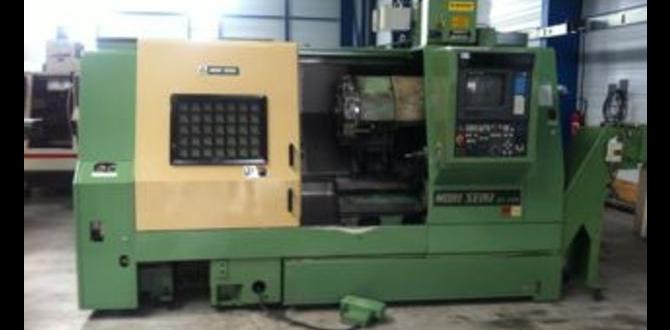Quick Summary: For cutting stainless steel, a 1/8″ carbide end mill, especially one with a 1/4″ shank and standard length designed for tough materials, is a reliable choice. Look for good chip evacuation features to prevent overheating and extend tool life.
Working with hard materials like stainless steel can feel a bit intimidating, right? You might have heard that it’s tricky to machine, and finding the right tool can make all the difference. If you’re looking to cut stainless steel with your milling machine, especially with a 1/8-inch end mill, you’re in the right place. We’re going to dive into what makes a specific 1/8-inch carbide end mill a winner for this tough job. It’s all about choosing the right cutter that can handle the heat and the hardness, giving you clean cuts every time. Stick around, and we’ll make sure you feel confident about tackling stainless steel.
Choosing the Right 1/8″ Carbide End Mill for Stainless Steel
Stainless steel is a fantastic material for many projects, but it’s notoriously challenging to machine. It’s tough, sticky, and tends to work-harden, which can quickly dull or break standard cutting tools. This is where a specialized carbide end mill comes into play. For a 1/8-inch diameter, selecting a tool specifically designed for stainless steel is crucial. We’re focusing on a 1/8″ carbide end mill, often with a 1/4″ shank, which offers a good balance of rigidity and maneuverability for smaller features. Let’s break down what makes these tools so effective.
Why Carbide?
Carbide, officially known as tungsten carbide, is an extremely hard compound formed from tungsten and carbon atoms. Its hardness is its superpower. Here’s why it’s the go-to material for machining stainless steel:
- Exceptional Hardness: Carbide is significantly harder than high-speed steel (HSS), which means it can cut through dense, tough materials like stainless steel without dulling as quickly.
- High-Temperature Resistance: Machining stainless steel generates a lot of heat. Carbide’s ability to withstand high temperatures without losing its cutting edge is vital. It allows for faster cutting speeds and feeds without compromising the tool.
- Wear Resistance: This means the cutting edge stays sharp for longer, even when subjected to the abrasive nature of stainless steel. This translates to more consistent cuts and fewer tool changes.
The Importance of the 1/8″ Diameter and 1/4″ Shank Combo
The 1/8-inch diameter is ideal for creating fine details, small pockets, or doing precision work on prototypes and intricate parts. When paired with a 1/4-inch shank, you get a tool that’s stiff enough to resist deflection, especially important in smaller diameters. A thicker shank prevents the thin cutting edge from wobbling or breaking under the pressure of cutting stainless steel. This combination offers rigidity without being overkill for smaller jobs.
Key Features for Stainless Steel: Chip Evacuation
One of the biggest challenges when milling stainless steel is managing the chips produced. Stainless steel tends to produce long, stringy chips that can recut themselves, leading to increased heat, tool wear, and poor surface finish. This is where the design of the end mill is critical, particularly its ability to evacuate chips.
- Flute Design: End mills designed for stainless steel often have specific flute geometries. For 1/8″ carbide end mills, this might mean:
- Higher Helix Angle: A higher helix angle (e.g., 30-45 degrees) helps to lift and eject chips more effectively from the cutting zone.
- Polished or Bright Flutes: Smooth, polished flutes reduce friction and help chips slide away more easily, preventing them from sticking.
- Number of Flutes: For stainless steel, generally, fewer flutes (2 or 3) are preferred for machining. This provides more chip room, which is essential for clearing out those long, stringy chips. A 1/8″ end mill might commonly have 2 flutes for this reason.
- Coatings: While not always standard on every 1/8″ carbide end mill, specialized coatings can significantly improve performance on stainless steel.
- TiN (Titanium Nitride): Adds hardness and lubricity, reducing friction and heat.
- TiCN (Titanium Carbonitride): Offers better abrasion resistance and hardness in higher temperature zones.
- AlTiN (Aluminum Titanium Nitride): Excellent for high-temperature applications, forming a protective oxide layer that prevents galling and wear. This is often a top choice for stainless steel.
Proven 1/8″ Carbide End Mill Specifications for Stainless Steel 316
When you’re specifically targeting a material like Stainless Steel 316, you need to know the hallmarks of a tool that’s proven to work. SS316 is known for its excellent corrosion resistance, especially in chloride environments, but it’s also one of the tougher stainless steels to machine. Here’s what to look for in a 1/8″ carbide end mill:
Material: Solid Carbide
This is non-negotiable for good performance on stainless steel. Look for “Solid Carbide” in the product description. While some tools might have carbide tips brazed onto a steel body, for this application, a solid carbide end mill provides the best rigidity and heat resistance.
Diameter: 1/8 inch (0.125″)
Precisely what you need for intricate work.
Shank Diameter: 1/4 inch (0.250″)
As mentioned, this provides crucial rigidity for a 1/8″ cutting diameter, reducing deflection and potential breakage.
End Mill Type: Square End or Ball Nose
A square end mill is versatile for pockets, slots, and profiles. A ball nose end mill is used for creating curved surfaces, fillets, or 3D contouring. For general-purpose work on SS316, a square end is usually the starting point.
Number of Flutes: 2 or 3
As discussed, this is critical for chip evacuation in sticky materials like stainless steel. 2-flute end mills offer maximum chip clearance, while 3-flute mills can sometimes offer a smoother finish and slightly better rigidity. For SS316, 2 flutes are generally favored for pocketing and roughing.
Helix Angle: Moderate to High (30° – 45°)
A higher helix angle helps to shear the material more effectively and lifts chips out of the flute efficiently. This is key to preventing re-cutting of chips and reducing heat buildup.
Coating: AlTiN or TiCN
For stainless steels like SS316, an Aluminum Titanium Nitride (AlTiN) coating is highly recommended. It creates a hard, heat-resistant layer that protects the carbide substrate from the extreme heat generated during cutting. Titanium Carbonitride (TiCN) is another good option, offering excellent abrasion resistance.
Chip Breaker Feature (Optional but Beneficial)
Some specialized end mills feature a “chip breaker” geometry on the cutting edge. This is a small, serrated edge that helps to break the long, stringy chips of stainless steel into smaller, more manageable pieces. This significantly improves chip evacuation and reduces tool load.
Example of a Specification: A tool might be marketed as “1/8″ Shank 1/4″ Solid Carbide End Mill, 2 Flute, 30° Helix, AlTiN Coated, for Stainless Steel.”
Step-by-Step Guide: Using Your 1/8″ Carbide End Mill on Stainless Steel
Now that you know what to look for, let’s get to the practical side. Properly setting up and running your end mill is just as important as choosing the right tool. Safety first, always!
Step 1: Machine Setup and Workholding
Your workpiece must be absolutely secure. Stainless steel can exert significant forces, and any movement can lead to tool breakage or poor cut quality.
- Secure the Workpiece: Use a vise with hardened jaws, clamps, or a fixture that provides a firm grip on your stainless steel stock. Ensure the workpiece is clean and free of debris before clamping.
- Tool Holder: Use a good quality tool holder, such as a collet chuck or a hydraulic holder, to ensure concentricity and a secure grip on the 1/4″ shank of your end mill. A worn or poor-quality holder can lead to runout, which is detrimental to tool life and surface finish.
- Tool Length: Minimize the amount of end mill shank that is unsupported in the tool holder. The less overhang, the less flex and vibration, especially with a 1/8″ diameter.
Step 2: Setting Up the Milling Machine
Whether you’re using a manual mill or a CNC, proper setup is key.
- Spindle Speed (RPM): This is critical. Stainless steel requires slower speeds than softer materials like aluminum. For a 1/8″ carbide end mill, you might start in the range of 1500-3000 RPM, depending on your machine’s capabilities and the specific grade of stainless steel. Always consult the tool manufacturer’s recommendations if available.
- Feed Rate: This is how fast the tool moves into the material. For stainless steel, you need a consistent, relatively slow feed rate. A common starting point might be 0.001″ to 0.003″ per tooth per revolution. Too fast, and you risk breaking the tool; too slow, and you can rub and generate excessive heat.
- Depth of Cut (DOC): For a 1/8″ end mill, especially in stainless steel, take shallow depths of cut. A radial depth of cut (how far you move sideways into the material) of 40-50% of the tool diameter is a good starting point. A axial depth of cut (how deep you plunge into the material) should be conservative, perhaps no more than 1x to 1.5x the tool diameter, or even less for roughing passes.
- Coolant/Lubrication: Machining stainless steel generates significant heat. You must use a cutting fluid or lubricant. Flood coolant is ideal. If not available, use a high-quality cutting fluid applied directly to the cutting edge with a brush or spray. This will cool the cutting zone, lubricate the cut, and help flush chips away. Check out resources on cutting fluid applications, like those from the Society of Manufacturing Engineers (SME) for best practices.
Step 3: Making the Cut
Once everything is set, it’s time to cut.
- Plunging: If you need to plunge straight down, do so at a slow feed rate and, if possible, with a helical interpolation or pecking cycle to clear chips.
- Pocketing: For pockets, use a climb milling strategy if your machine allows (consult your machine’s manual). Climb milling can provide a better surface finish and reduce cutting forces, but it requires a rigid setup.
- Profiling: When milling around a perimeter, again, climb milling is often preferred.
- Per-Pass Strategy: Take light passes. It’s better to make multiple shallow passes than one deep, aggressive pass. This is especially true with a 1/8″ end mill and stainless steel.
- Listen and Observe: Pay attention to the sound of the cut. A smooth, consistent whirring sound is good. Chattering, squealing, or grinding noises indicate you need to adjust your speeds, feeds, or depth of cut. Also, watch the chips being produced; they should be small and curl away cleanly, not look like fine dust (too hot) or long, stringy loops (not breaking).
Step 4: Chip Management and Finishing
Good chip management is an ongoing process.
- Clear Chips: Periodically pause the machine to clear any accumulated chips, especially in deep pockets or difficult-to-reach areas. Compressed air can help, but be careful not to blow chips into your machine’s ways or control systems.
- Finishing Passes: For critical features requiring a high-quality surface finish, make a final finishing pass with a shallow depth of cut and a slightly faster feed rate.
Common Stainless Steel Grades and End Mill Suitability
Not all stainless steels are created equal. Their composition greatly affects machinability. While our focus is on SS316, understanding other common grades helps place this tool’s capabilities in context.
| Stainless Steel Grade | Machinability Characteristics | Suitability for 1/8″ Carbide End Mill |
|---|---|---|
| 304 | Most common, good corrosion resistance but can be gummy and work-harden significantly. | Good. A standard carbide end mill designed for stainless steel will perform well. Pay attention to chip evacuation. |
| 316 | Excellent corrosion resistance (especially to chlorides due to molybdenum content). Harder and tougher than 304, prone to galling. | Excellent. Requires a high-performance carbide end mill with good rigidity, heat resistance (AlTiN coating recommended), and superior chip evacuation. |
| 17-4 PH | Precipitation hardening stainless steel. Can be machined in the annealed state but very hard in the hardened condition. | Good in annealed state. For hardened 17-4 PH, heavy-duty, specialized tooling with strong coatings and robust geometries is usually required. A standard 1/8″ carbide might struggle. |
| 410 | Martensitic stainless steel. Can be heat-treated to high hardness. Machinability varies greatly with heat treatment. | Moderate. Machinable in the annealed state, but can be abrasive. A good carbide end mill will work, but speeds and feeds need careful adjustment. |
The 1/8″ carbide end mill with the specified features (1/4″ shank, good fluting for chip evacuation, potentially AlTiN coating) is particularly well-suited for the demands of Stainless Steel 316, offering the necessary hardness, heat resistance, and cutting edge integrity.
Troubleshooting Common Issues
Even with the right tool, you might run into problems. Here’s how to tackle them:
- Tool Breakage: This is often due to:
- Excessive feed rate or depth of cut: Reduce your DOC and feed.
- Poor chip evacuation: Clear chips more frequently, try a different cutting fluid, or ensure your flute design is adequate.
- Workpiece movement: Re-secure your workpiece.
- Tool overhang: Minimize the amount of end mill sticking out of the holder.
- Toolholder issues: Ensure your toolholder is clean and providing a tight, concentric grip.
- Poor Surface Finish: This can be caused by:
- Tool deflection: Due to light cuts, insufficient rigidity, or workholding issues.
- Built-up edge (BUE): Material welding to the cutting edge. Use better lubrication, higher cutting speeds (within tool limits), or a coating like AlTiN.
- Chatter: Often caused by machine rigidity, tool rigidity, or inappropriate feed/speed.
- Recutting of chips: Improve chip evacuation.
- Overheating:
- Insufficient coolant/lubrication: Apply more, or use a higher-quality fluid.
- Too high of a cutting speed or feed rate.
- Poor chip evacuation: Chips are not being removed from the cutting zone, trapping heat.
Why Standard Length Might Be Just Right
You might see end mills advertised as “extended reach” or “extra length.” For a 1/8″ diameter, a “standard length” end mill typically means the flute length is around 1/2 inch to 1 inch. This length is often perfectly suited for most beginner and intermediate projects for several reasons:
- Rigidity: Shorter flute lengths on smaller diameter tools contribute significantly to overall rigidity. This is paramount when cutting tough materials like stainless steel.
- Cost-Effectiveness: Standard length tools are generally less expensive than custom or extended reach versions.
- Availability: They are widely available from most tool suppliers.
- Sufficient for Most Work: Unless you need to machine very deep slots or holes that exceed the standard flute length, a standard geometry will serve you well. For 1/8″ diameter work on stainless steel, depth of cut is usually constrained by rigidity and heat long before flute length becomes the limiting factor.
When looking for that proven 1/8″ carbide end mill for stainless steel, a standard length carbide end mill







